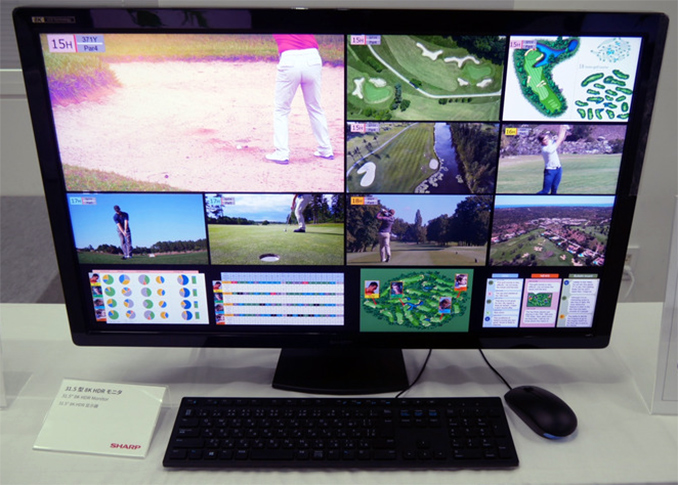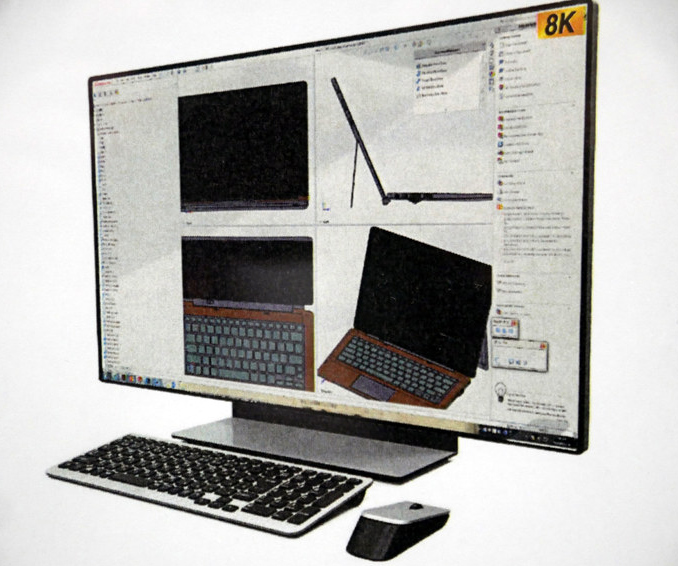Sharp Demonstrates 31.5-Inch 8K 120Hz HDR Monitor
by Anton Shilov on April 11, 2019 2:00 PM EST
Sharp this week demonstrated its first 31.5-inch HDR display featuring a 7680×4320 resolution and a 120 Hz refresh rate. The monitor uses the company’s IGZO technology and the manufacturer evaluates plans to release this LCD commercially.
Being one of the key backers of an 8K resolution as well as the Super Hi-Vision format, Sharp was among the first to release 8K screens and 8K cameras for professionals as well as 8K UHD TVs for consumers. Several years ago, Sharp demonstrated its first 27-inch 8K IGZO monitor with a 120 Hz refresh rate and 1000 nits luminance, but the device has never been released commercially (at least, it has not been available in stores). This week the company showcased another 8Kp120 display.
Demonstrated at a special media event in Sharp’s headquarters in Tokyo, the new prototype is a 31.5-inch IGZO LCD featuring a 7680×4320 resolution, 800 nits brightness, and a 120 Hz refresh rate. The new monitor is larger than its predecessor, yet features a lower pixel density, and lower luminance, so it should be a bit easier to manufacture (at least from cooling and PPI points of view).
Sharp did not disclose many technical details about its new 31.5-inch 8K LCD, yet the company is considering to launch it commercially. Meanwhile, one of the key questions is how the display will connect to host machines. To feed its 27-inch 8K monitor with data (7680×4320 at 10 bits at 120 times a second requires a minimum bandwidth of 120 Gbps or 15 GB/s), Sharp had to use eight DisplayPort cables back in 2016. VESA started to certify DP1.4 with HBR3 (DP8K) 32.4 Gbps cables in early 2018 and their use could reduce the number of DP connectors needed for 8Kp120 monitors. Usage of four cables is still too complicated for the mass market, yet it is acceptable for professional applications.
In addition to its 31.5-inch 8K HDR display, Sharp also showcased a picture of its all-in-one PC allegedly featuring the same 8K LCD panel. Development of such a PC may indicate that the company’s 8Kp120 HDR panel does not heat too much and it is possible to install compute components essentially on its back (though this is a speculation). Meanwhile, as paradox as it may seem, building an 8Kp120 AIO PC may be somewhat easier than building a desktop PC for such a display using the currently available technologies due to less clutter with cables, certifications, and so on.
At this point Sharp’s 8Kp120 AIO desktop is a prototype and it is unclear whether something like this could be released commercially any time soon. Meanwhile, Foxconn, the owner of Sharp and the world’s largest contract maker of electronics, has a lot of talented engineers who helped Apple to build its iMac Pro AIO workstation.
Related Reading:
- CEATEC 2016: Sharp Showcases 27-inch 8K 120Hz IGZO Monitor with HDR, also 1000 PPI for VR
- Philips Demos 328P8K: 8K UHD LCD with Webcam, Docking, Coming in 2018
- Dell Announces UP3218K: Its First 8K Display, Due in March
- Sharp Announces 2nd Gen 8K UHD TVs at IFA
- Samsung's 2019 QLED UHD TVs: 8K TVs Revamped, 4K TVs Get New Panel & Backlighting
- New 8K OLED Displays for Tablets and Laptops: 8.3 and 13.3 Inches
- Sharp’s 8K UHD TV Available in Japan, Listed in Europe for €11,899
Source: PC Watch











21 Comments
View All Comments
p1esk - Thursday, April 11, 2019 - link
It should only need two DP1.4 cables, not four. Or a single HDMI 2.1 cable.drgigolo - Friday, April 12, 2019 - link
No? This is 120Hz. Double the bandwidth of 8K @ 60Hz.GreenReaper - Thursday, April 11, 2019 - link
I could manage two cables! But HDMI 2.1 with Display Stream Compression should do it in one:https://en.wikipedia.org/wiki/HDMI#Version_2.1
Meanwhile DisplayPort 1.4a only support 8k in 30-bit@60Hz, so you'd need two for the whole screen - although 60Hz isn't *that* bad for most purposes, particularly if combined with Freesync 2.
Whether anything can output that for anything beyond fixed-function video is another matter. But I like to think Navi might, since a derivative looks to be the basis for the next console generation.
repoman27 - Thursday, April 11, 2019 - link
The total bandwidth including overhead for 7680 x 4320, 10 bpc, 120 Hz works out to 127.75 Gbit/s, which just squeaks under the HDMI 2.1 limit if you can get a full 3:1 ratio out of DSC, otherwise you're looking at chroma subsampling. There aren't currently any HDMI 2.1 FRL capable sources on the market though.NVIDIA RTX cards should be able to drive this display with two DisplayPort cables using both HBR3 and DSC. Meanwhile AMD GPUs with HBR3 support and 6 DisplayPort outputs but no DSC could probably manage with 6 cables.
GreenReaper - Thursday, April 11, 2019 - link
Maybe if the scuttlebutt about there being a version of DisplayPort 2.0 that runs at 20Gbps is true, they can fit it in with lighter compression:https://e2e.ti.com/support/interface/f/138/t/77199...
Of course even if it is, we may not see anything supporting it 'til 2020.
DanNeely - Friday, April 12, 2019 - link
They officially announced that v.next would support uncompressed 8k60 as CES. No mention of if that was at 8 or 10 bit/color (HDR); so my cynic-sense is going to predict that will still need DSC.https://www.forbes.com/sites/moorinsights/2019/02/...
repoman27 - Sunday, April 14, 2019 - link
VESA stated that DP next generation would more than double DP 1.4a capabilities, and would reduce protocol overhead. So if they simply double the signaling rate to 16.2 Gbit/s per lane and switch to a more efficient encoding scheme such as 64b/66b, that would provide 62.836 Gbit/s of bandwidth for a 4-lane main link. That's enough to (just) accommodate 7680 x 4320, 10 bpc, 60 Hz without chroma subsampling or DSC.However, it still falls short of fully meeting Rec. 2020 without compression, which calls for 12 bpc at that resolution and frame rate. If VESA were to adopt Thunderbolt 3 signaling and cables for DP next gen (20.625 Gbit/s with 64b/66b encoding) and run all four lanes in the same direction, we'd get an 80 Gbit/s link. That would be able to handle up to 8192 x 4320, 12 bpc, 60 Hz (RED 8K Full Format) losslessly, and up to 8192 x 5120, 12 bpc, 144 Hz (16:10, high refresh rate) with DSC. So 20 Gbit/s DP makes a lot of sense.
Hxx - Thursday, April 11, 2019 - link
nice. my next monitor in 2025 when they actually will be affordablec4v3man - Thursday, April 11, 2019 - link
The technology landscape is littered with designs that seem excessive at first, but eventually become outdated and underwhelming. Things like high-resolution VGA displays on your phone, gigabyes of memory, 1TB hard drives...I don't see why you'd need an 8K 120Hz desktop display... 8K, sure I can understand for photo manipulation, high end video creation, CAD, and the security/surveillance markets. I can understand why you'd want 120hz or higher, for gaming purposes. And I can see why you'd want an 8k 120hz headset for virtual reality use.
But I feel making an 8K60 desktop display would be far more commercially viable, and lessen the cabling headache. Or it'd make more sense if it was maybe 40-50", where it could be used to replace 4x 4K monitors as a "borderless tiled multi-display" setup.
Lakados - Thursday, April 11, 2019 - link
8K@60 may seem more commercially viable but the reality is the panels they are having to use to make this work are running at 120hz or better by their very nature so the costs associated with setting up a specific screen production run would probably greatly increase the productions costs for no actual benefit other than to offer a lower refresh rate.